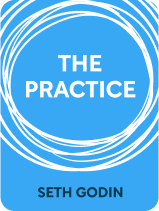

This article is an excerpt from the Shortform book guide to "The Practice" by Seth Godin. Shortform has the world's best summaries and analyses of books you should be reading.
Like this article? Sign up for a free trial here.
Who is your art’s audience? Should you make work for yourself or for other people?
The Practice by Seth Godin claims that finding your art’s purpose involves figuring out who the work is for. Maybe your art is just for yourself, or maybe it’s for other people who might enjoy your work.
Read below to decide who you should make art for.
Who Is Your Work For?
Godin argues that you need to establish your intent not just about what you’re trying to do but also about who you’re doing it for. In other words, you need to consider your art’s audience. Of course, you can choose to create for yourself alone, but Godin claims that’s not professional work because it’s not serving anyone but yourself. Knowing who your work is for creates a responsibility to bring positive change to those people.
In asking yourself who your work is for, there are a couple of considerations. First, don’t try to appeal to everyone. People who like horror films might not like your romantic comedy, but you’re not making it for them. In fact, one measure of whether work is “good” is simply whether it resonates with the specific audience to whom you’re directing it.
Second, if you’re making something for someone else, you have to truly understand and empathize with what they want and need. For example, if you’re a teacher designing an arts curriculum for a group of underserved kids, you can’t assume that they’ll have the resources to buy lots of expensive art supplies. You’ll need to have an understanding of what materials they do have on hand in their daily lives that could be used to create art projects.
To understand your audience, Godin recommends that you start with a small group of people who care about your work and think about what they want. Be specific. What do they believe? What do they love? What do they need?
This doesn’t mean tailoring your work exclusively to please other people. It means considering the needs of the people who are interested in the work you do because without them, you’d have no audience.
You can’t create art that’s exclusively for others or exclusively for yourself, Godin says. If you try to create something that’s exactly what you want, what you’re really doing is trying to force other people to want what you want or see things through your eyes. You need to empathize with the audience you’re trying to reach.
The Personal as Universal
Just as Gilbert takes issue with Godin’s thoughts about the purpose of art, she also disagrees to some extent with his emphasis on understanding and empathizing with your audience. She uses her own best-selling memoir, Eat Pray Love, as an example. She says she wrote the book to understand herself better. It ended up helping a lot of readers understand themselves better, too—but if her sole intent had been to help others, she might have written a book that was far less popular with her audience.
Many successful artists subscribe to this view that the more personal a work is, the more universal it is. Memoirists, in particular, often say that in writing about their own lives, they are moved by a desire to express what it means to be human. By examining their own inner struggles and personal experiences, writers such as Cheryl Strayed, Anne Lamott, and Meghan Daum say that they hope to give readers permission to feel their own messy emotions and gain new insight into their own lives.

———End of Preview———
Like what you just read? Read the rest of the world's best book summary and analysis of Seth Godin's "The Practice" at Shortform.
Here's what you'll find in our full The Practice summary:
- Why creativity doesn't require any “magic”
- How creativity is a skill that anybody can learn
- Step-by-step lessons on how to be creative






